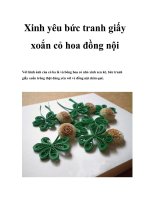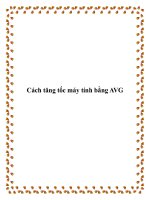Cách xếp rồng có cánh bằng giấy docx
Bạn đang xem bản rút gọn của tài liệu. Xem và tải ngay bản đầy đủ của tài liệu tại đây (105.78 KB, 14 trang )
1.) Fold and unfold.
2.) Fold and unfold just the corners.
3.) Fold and unfold just the corners.
4.) Fold and unfold.
5.) Fold and unfold.
6.) Flip over
Dragon In Flight (Version 2.5)
By Charles Esseltine.
I suggest that you should use a large (9 inch or larger) piece of foil (Florist foil is the best in my opinion.), for your first model. You can make the model from just
about any paper (Kami, Washi, waxed, plain, etc ), but the model will tend of suffer paper spread. So foil is the best. And Florist foil is very forgiving. If you
make a mistke, I mean mistake, it can be undone, and most creases can be pressed out. Begin the model white side up.
16.) Fold the flap back
and forth.
19.) Petal fold. Now you
have a small Bird Base.
7.) Fold and unfold. Then flip over.
8.) Fold the sides in. The corners will
form mini-preliminary bases.
9a.) Choose one corner for
the head.
9b.) Fold the flap
to the tip.
10.) Fold into the
center line.
11.) Unfold one flap.
12.) Squash fold.
13.) Fold it back.
14.) Repeat steps
11 - 13 on the other
side.
15. Petal fold.
17.) Unwrap the outer
layers. You will have to
partially unfold it to do
so. Refold the bottom.
18.) Squash fold.
X
26.) Petal Fold
Front and Back
X
27.) Pull out the inner
edges. Taking care not
to unfold the head (X)
Press flat.
X
X
X
28.) Repeat on
the back, but
unfold the tail as
well. Flip over.
20.) Fold the other three corners as shown. 21.) Fold into
a preliminary
base. Watch
the X.
22.) With the X
layers in front, fold
the sides to the
center line. Repeat
behind.
23.) Fold the point down to meet
the edges formed in the last step.
X
24.) Sink the tip on the
line created by the last
fold. If you partially
unfold it, it will be
much easier.
25.) Open up the sides.
29.) The tail should look
like this. Flip over.
34.) Flip all of the layers
of the head, to the other
side.
35.) Repeat steps 31
through 33 on the other
side.
30.) Fold the layers of
the head together.
31.) Fold the top layers
to the center. Then
unfold.
32.) Squash fold
33.) Flip this layer back. 36.) Open the
layers of the head,
38.) Using the other side
as a guide for these
folds. Make a rabbit ear.
39.) Squash fold.
40.) Petal fold the tail.
41.) Inside reverse fold the wing outward.
Opening the wingtips as you do. The leading
edges will line up with line AB
A
B
42.) Fold the inner layer up on the front and back
of each wing.
37a.) Fold the edges into
rabbit ears.
37b.) The completed
folds. Now flip over.
43.) Fold down the front and back layers.
44.) Do a combination fold. Bring the top edge into
the centerline. This will lift up the top layer of the
wing. When the fold is complete, this edge will lie along
the leading edge of the wing. Repeat this on the other
three sides.
45.) Now open one side.
46.) Now we get to the fun part! First bring the Far edge (A) to meet the unfolded edge (B). This will bring the first bisector fold (C) to the
center line (D). This will bring the wing's leading edges up as well. Fold the same as with the body, bringing the valley fold (c) to meet the
leading edge (d). When the folds are complete the model will not lie flat. In fact the two edges will be at right angles to the rest of the model.
C
D
A
B
d
c
47.) Now fold the standing layers down.
48.) Compound fold the remaining layers along the same lines as in step 43. The model will now lie flat.
A
B
49a.) Now repeat steps 45 - 48 on the other sides.
49b.) The model should look like this. This is also a good
time to flatten the dragon as much as possible. Make all of
the creases as sharp as you can. Here is where a hard flat
surface comes in handy. You can also use a rolling pin, if one
is handy.
50.) Open out the model. Pulling the head and tail sections out, so that they lie flat, with the center section above the
wings standing perpendicular to the rest of the model. This easier done than said. You'll see what I mean, by looking at
the next step.
51a.) The next few steps deal
with the center section. First
open the middle. Spreading as
you go.
51b.) As the bottom spreads out it will
form a square box.
51c.) Finished. The edges don't have to be
sharp, but it helps.
52a.) Bring in the sides, while you pull the front
and back outwards. Flatten the model.
52b.) It will look like this when done.
53.) Flip over.
54.) Fold the head and tail sections to one side. 55.) Fold the edge into the center, shaping the
wing as you go.
56.) Flip both layers of the wing forward.
57.) Repeat step 55 on the back.
58.) Flip the wing, head, and tail over.
59.) Repeat 55-57. And return the
wing to its' starting position
60.) It's starting to look like a dragon, isn't it?
Rotate 90 degrees.
90
0
a. b.
61a.) Fun Time! No we fold the model ALMOST in half. The
center section is rather THICK. So we fold the head and tail in
half (a), but the bottom is to be folded in a U shape (b) with the
bottom almost flat.
61b.) The wings should be between 30 and 90
degrees depending on what pose you want the dragon
to have. For the next steps we zoom in to the legs.
62.) Roll the leg down as far
as it will go.
63.) Pinch the tip.
64a.) Repeat steps 62 & 63
for the other legs.
64b.) The legs are done.
Let's move on to the wings.
65.) Fold the leading edge back. This will
cause the wings to move forward. The model
will not lie flat.
66a.) From the marker
fold, unfold all the layers.
This causes the wing to
take on a curve. You can
adjust this fold to reflect
different wing positions.
Then curve the
wingtip along the existing
lines.
Repeat on the other
wing. Shaping them to
taste.
66b.) The wings are done.
67.) Wrap the sides of the tail fin over
the tail.
68.) With a soft crease, curve the tail fin.
69.) Outside reverse fold all layers of
the head as shown.
70.) Fold the first layer to the top to
make the eyes.
71.) Inside reverse fold down the
mouth. You don't have to pull it all the
way down. Do the mouth to taste.
72.) Inside reverse fold the teeth.
73.) With a pencil, or a similarly pointed object,
open the eyes.
74.) Spread the ears slightly.
75.) Daragon done!









